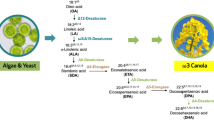Abstract
The main aim of the present study was to examine the impact of some biological and environmental factors on the lipid and fatty acid compositions of farmed Atlantic salmon (Salmo salar), with special emphasis on Ω3 fatty acids. Two year groups of salmon at nine fish farms distributed along the Norwegian coast were fed the same diet and were sampled every second month. The data are believed to give a representative characterization of lipid and fatty acid content of salmon farmed in Norway.
Multiple regression analysis revealed that variation in lipid content and body weight explained 80% of the variation found in Ω3 fatty acids in farmed salmon, and 22:6 Ω3 showed greater variation than other Ω3 fatty acids. Further analysis of lipid-corrected values revealed only minor effects of latitude on the per cent content of highly unsaturated Ω3 fatty acids, and hardly any effect of seawater temperature, with the exception of 22:6 Ω3, which decreased slightly with increasing temperature.
The per cent 22:6 Ω3 in the fillet became gradually reduced with increasing fish age and body weight, whereas the content of 20:5 Ω3 and other Ω3 fatty acids remained relatively constant. The per cent content of 22:6 Ω3 of young salmon was higher than in the feed, but approached the feed value gradually as body weight increased. The lipid content of the salmon increased with fish age, and the absolute quantitative contents of both 22:6 Ω3 and 20:5 Ω3 increased meanwhile, even though the per cent content of 22:6 Ω3 decreased quite pronouncedly.
The per cent 22:6 Ω3 and other Ω3 fatty acids was higher in wild than in farmed salmon, but the absolute quantitative content was higher throughout in farmed salmon, which had higher lipid contents. The Ω3/Ω6 ratio, which is important in human health evaluation, was lower in farmed than in wild salmon. The large flexibility of Ω3 fatty acids and lipid content of farmed salmon leave us with the option of producing a wide variety of salmon qualities requested by the market. Both per cent and absolute quantitative Ω3 contents, as well as the Ω3/Ω6 ratio, may readily be manipulated.
Similar content being viewed by others
References
Bligh, E.G. and Dyer, W.J. (1959) A rapid method of total lipid extraction and purification. Canadian Journal of Biochemistry and Physiology 37, 911–917.
Castledine, A.J. and Buckley, J.T. (1982) Incorporation and turnover of essential fatty acids in phospholipids and neutral lipids of rainbow trout. Comparative Biochemistry and Physiology 71B, 119–126.
Farkas, T., Csengeri, I., Majoras, F. and Olah, J. (1980) Metabolism of fatty acids in fish III. Combined effect of environmental temperature and diet on formation and deposition of fatty acids in the carp, Cyprinus carpio Linnaeus 1758. Aquaculture 20, 29–40.
Henderson, R.J., Sargent, J.R. and Pirie, B.J.S. (1982) Peroximal oxidation of fatty acids in livers of rainbow trout (Salmon gairdneri) fed diets of marine Zooplankton. Comparative Biochemistry and Physiology 73B, 565–570.
Kinsella, J.E. (1987) Seafoods and Fish Oils in Human Health and Disease. Marcel Dekker, Inc.: New York and Basel.
Lie, ø., Waagbø, R. and Sandnes, K. (1988) Growth and chemical composition of adult Atlantic salmon (Salmo salar) fed dry and silage-based diets. Aquaculture 69, 343–353.
Metcalfe, L.D., Schimtz, A.A and Pelka, J.R. (1966) Rapid preparation of fatty acid esters from lipids for gas chromatography. Analytical Chemistry 38, 514–515.
Olsen, R.E., Henderson, R.J. and Ringø, E. (1991) Lipids of Arctic charr, Salvelinus alpinus (L.) I. Dietary induced changes in lipid class and fatty acid composition. Fish Physiology and Biochemistry 9, 151–164.
Olsen, Y. and Skjervold, H. (1991) Impact of latitude on n-3 fatty acids in wild Atlantic salmon. Omega 3 News, VI: 1–4.
Sargent, J.R., Henderson, R.J. and Tocher, D.R. (1988) The lipids. In: Fish Nutrition (2nd edn) (ed. J.E. Halver) Academic Press: San Diego, pp. 153–218.
Viga, A. and Grahl-Nielsen, O. (1990) Genotypic and phenotypic fatty acid composition in the tissues of salmon, Salmo salar. Comparative Biochemistry and Physiology 96B, 721–727.
Waagbø, R., Sandnes, K., Sandvin, A. and Lie, ø. (1991) Feeding three levels of n-3 polyunsaturated fatty acids at two levels of vitamin E to Atlantic salmon (Salmo salar). Growth and chemical composition. Fiskeridirektoratets Skrifter, Serie Ernœring IV, 51–63.
Author information
Authors and Affiliations
Rights and permissions
About this article
Cite this article
Olsen, Y., Skjervold, H. Variation in content of Ω3 fatty acids in farmed Atlantic salmon, with special emphasis on effects of non-dietary factors. Aquacult Int 3, 22–35 (1995). https://doi.org/10.1007/BF00240918
Issue Date:
DOI: https://doi.org/10.1007/BF00240918




